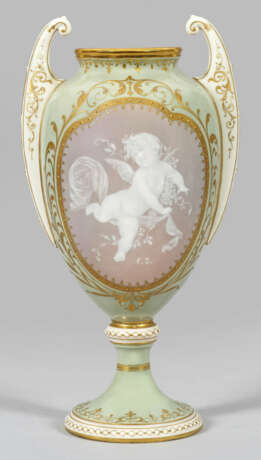ID 1339736
Lot 565 | Prächtige Meissen Pokalvase mit Pâte-sur-pâte-Malerei
Estimate value
€ 8 500 – 17 000
Eingezogener Fuß mit umlaufenden Emailcabochons. Gestreckt ovoider Korpus mit seegrünem Fond sowie seitlichen Volutenhenkeln, gerundeter Schulter mit profiliertem Goldrand. Schauseitig der Wandung vielpassige Reliefgoldkartusche mit der Darstellung eines fliegenden Amors, einen hauchzarten Umhang mit Blütenbändern tragend. Auf grauviolettem Grund mit äußerst feiner, weißer Pâte-sur-pâte-Malerei. Verso kleines Ornament in Reliefgold. Monogr.; Modell-Nr. F 25. Unw. rest.; Schwertermarke. H. 29 cm.
Bei der Pâte-sur-Pâte-Malerei handelt es sich um eine Schlickermalerei, wobei durch das schichtweise Auftragen von flüssiger, teilw. durchscheinender Schlickermasse ein erhabenes, kameenartiges Relief entsteht. Diese hochqualitative Maltechnik wurde erstmals auf der Londoner Weltausstellung im Jahr 1851 von der Manufaktur Sèvres vorgestellt. Die Umsetzung auf Meißener Porzellan erfolgte 1878 durch den Chemiker Dr. Heintze und erreichte seinen Höhepunkt auf der Weltausstellung 1893 in Chicago mit ca. 1000 dort vertretenen Ausstellungsstücken. Besonders Ludwig Sturm (1844-1926) setzte sich in seiner Zeit von 1880 bis 1904 als Malereivorsteher und später als artistischer Direktor in der Meissener Manufaktur für moderne Dekortechniken wie die der Scharffeuer- und Pâte-sur-Pâte-Malerei ein und entwarf eine Schmucktruhe mit eingelegten "Pâte-sur-pâte"- Porzellanplatten für die Weltausstellung 1893 in Chicago, die großes Aufsehen erregte.
Vgl. Berling, Festschrift, S. 92-93.; Vgl. Jedding, Meißener Porzellan des 19. und 20. Jh., S. 90 f. u. S. 168.
A splendid sea green ground porcelain potpourri vase with cupid painted in pâte-sur-pâte. Painter's monogram. Insignificantly restored. Crossed swords mark.
Meissen. Ende 19. Jh.
| Address of auction |
Kunstauktionshaus Schloss Ahlden GmbH Große Str. 1 29691 Ahlden(Aller) Germany | ||||||||||||||
|---|---|---|---|---|---|---|---|---|---|---|---|---|---|---|---|
| Preview | |||||||||||||||
| Phone | +49 5164 80100 | ||||||||||||||
| Buyer Premium | 25.0 | ||||||||||||||
| Conditions of purchase | Conditions of purchase | ||||||||||||||
| Business hours | Business hours
|



